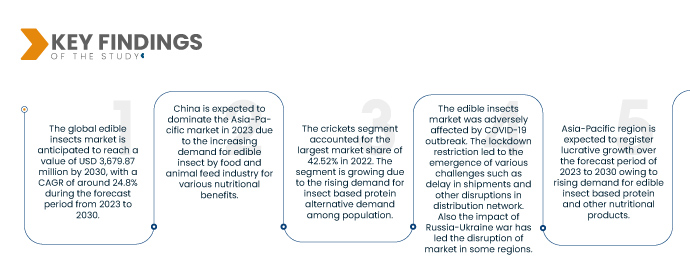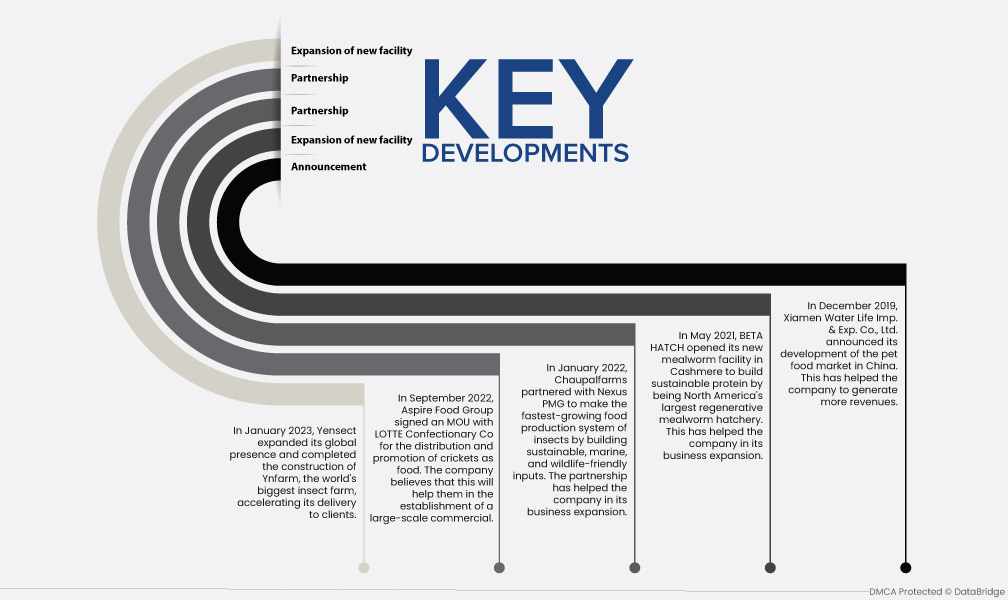The practice of eating insects is known as entomophagy which is traditional in many cultures. There are more than two thousand recorded species of edible insects across the globe. Edible insects such as crickets and grasshoppers (orthopterans), caterpillars (lepidopteran), various fly larvae (dipterans), and mealworms (coleopteran larvae) could provide an alternative meat source while improving food security.
Access full Report @ https://www.databridgemarketresearch.com/reports/global-edible-insects-market
In general, edible insects are rich in protein, fat, and energy and can also be a significant source of vitamins and minerals. Global demand for reared insects to provide animal protein in livestock and human diets is expected to increase in the coming decades due to a rapidly growing population and significant pressure on water, agriculture, forestry, and other natural resources.
For instance,
- In May 2022, as per NCBI report, Latin America is the second-largest market for edible insects in the world. Additionally, it is known that Mexico, Ecuador, Colombia, Brazil, and Venezuela consume the most insects as an alternative food source.
Data Bridge Market Research analyses that the Edible Insects Market is expected to grow at a CAGR of 24.8% in the forecast period of 2023 to 2030 and is expected to reach USD 3,679.87 million by 2030. The crickets segment among insect type is projected to propel the market's growth as crickets are the most consumed insect type among others.
Key Findings of the Study
Commercial Benefits of Insect Farming
Most edible insects are harvested in the wild, but a few insect species have been domesticated because of their commercially valuable products. Silkworms and bees are the best-known examples. Sericulture, the practice of rearing silkworms for the production of raw silk, has its origin in China.
Additionally, some insect species are reared for the pet-food industry. For instance, mealworms and crickets are reared primarily as pet food in Europe, North America, and parts of Asia. Another commercially viable product obtained from farmed insects is carminic acid. Carminic acid is derived from the cochineal insect (Dactylopius coccus). The acid is used as red dye in human food and in the pharmaceutical and cosmetic industries.
Insects are also reared in agriculture to either combat insect pests or for pollination. In biological control, large rearing companies mass produce beneficial insects such as predators and parasitoids. These insects are often sold to fruit, vegetable, and flower farmers to combat insect pests and are also used in large estate crops, for instance, egg parasitoids (Trichogramma spp.) and larval parasitoids (Cotesia flavipes) to combat sugarcane borers. Bumblebees (Bombus spp.) and honeybees (Apis spp.) are reared worldwide to help farmers pollinate crops and fruit orchards.
Report Scope and Market Segmentation
|
Report Metric
|
Details
|
|
Forecast Period
|
2023 to 2030
|
|
Base Year
|
2022
|
|
Historic Years
|
2021 (Customizable to 2014 - 2019)
|
|
Quantitative Units
|
Revenue in Million, Pricing in USD
|
|
Segments Covered
|
Insect Type (Crickets, Mealworms, Black Soldier Flies, Buffalo's, Grasshoppers, Ants, Silkworms, Cicadas, and Others), Insect Category (Regular Insects, and Premium Diet-Fed Insects), Application (Human Consumption Products, Animal Nutrition, Insect Oil, Pharmaceuticals, Cosmetics, Personal Care, and Others), Distribution Channel (Direct, Indirect)
|
|
Countries Covered
|
U.S., Canada, Mexico, Germany, France, U.K., Italy, Spain, Netherlands, Russia, Switzerland, Turkey, Belgium, Denmark, Sweden, Poland, Rest of Europe, China, Japan, India, South Korea, Australia, Singapore, Thailand, Malaysia, Indonesia, Philippines, Vietnam, New Zealand, Rest of Asia-Pacific, Brazil, Colombia, Peru, Rest of South America, South Africa, Saudi Arabia, U.A.E, Ethiopia, Qatar, Kuwait, Rest of the Middle East and Africa
|
|
Market Players Covered
|
Ynsect (France), Aspire Food Group (U.S.), Xiamen Water Life Imp. & Exp. Co., Ltd. (China), BETA HATCH (U.S.), Fluker's Cricket Farm (Louisiana), Entomo Farms (Canada), Invertapro AS (Norway), Enviroflight (U.S.), Insecteo (France), Kreca Ento-Feed BV (Netherlands), Chapul, LLC (U.S.), Jimini's (France), Symton Black Soldier Fly (U.S.), Armstrong Crickets Georgia (U.S.)
|
|
Data Points Covered in the Report
|
In addition to the insights on market scenarios such as market value, growth rate, segmentation, geographical coverage, and major players, the market reports curated by the Data Bridge Market Research also include depth expert analysis, patient epidemiology, pipeline analysis, pricing analysis, and regulatory framework.
|
Segment Analysis:
The global edible insects market is segmented into four notable segments such as insect type, insect category, application, and distribution channel.
- On the basis of insect type, the market is segmented into crickets, mealworms, grasshoppers, cicadas, black soldier flies, silkworms, ants, buffalo's, and others
In 2023, the crickets segment is expected to dominate the market due to its increasing demand among the population.
- On the basis of insect type, the global edible insects market is segmented into crickets, mealworms, grasshoppers, cicadas, black soldier flies, silkworms, ants, buffalo's, and others. In 2023, the crickets segment is expected to dominate the global edible insects market with a share of 42.93%. It is expected to reach USD 1,678.71 million by 2030, growing with a CAGR of 25.9% in the forecast period of 2023 to 2030.
- On the basis of insect category, the global edible insects market is segmented into regular insects and premium diet-fed insects. In 2023, the regular insects segment is expected to dominate the global edible insects market with a share of 65.70%. It is expected to reach USD 2,472.56 million by 2030, growing with the highest CAGR of 25.2% in the forecast period of 2023 to 2030.
- On the basis of application, the global edible insects market is segmented into human consumption products, animal nutrition, cosmetic and personal care, pharmaceutical, insect oil, and others. In 2023, the human consumption products segment is expected to dominate the global edible insects market with a share of 36.36%. It is expected to reach USD 1,441.79 million by 2030, growing with the highest CAGR of 26.2% in the forecast period of 2023 to 2030.
- On the basis of distribution channel, the global edible insects market is segmented into direct and indirect. In 2023, the direct segment is expected to dominate the global edible insects market with a share of 73.61%. It is expected to reach USD 2,734.91 million by 2030, growing with the highest CAGR of 25.0% in the forecast period of 2023 to 2030.
Major Players
Data Bridge Market Research recognizes the following companies as the market players in the global edible insects market are Ynsect (France), Aspire Food Group (U.S.), Xiamen Water Life Imp. & Exp. Co., Ltd. (China), BETA HATCH (U.S.), Fluker's Cricket Farm (Louisiana), Entomo Farms (Canada), Invertapro AS (Norway), Enviroflight (U.S.), Insecteo (France), Kreca Ento-Feed BV (Netherlands), Chapul, LLC (U.S.), Jimini's (France), Symton Black Soldier Fly (U.S.), Armstrong Crickets Georgia (U.S.).
Market Development
- In January 2023, Yensect expanded its global presence and completed the construction of Ynfarm, the world's biggest insect farm, accelerating its delivery to clients.
- In September 2022, Aspire Food Group signed an MOU with LOTTE Confectionary Co for the distribution and promotion of crickets as food. The company believes that this will help them in the establishment of a large-scale commercial.
- In July 2022, Yensect established its presence in the North America market by expanding its business. This will help the company generate more revenue.
- In June 2022, Aspire Food Group supported the advancement of insect agriculture through its sponsorship of the Educational Leadership Chair in the Production and Primary Processing of Edible Insects at Université Laval. The company believes this will help them spread awareness regarding edible insects.
- In January 2022, Chaupalfarms partnered with Nexus PMG to make the fastest-growing food production system of insects by building sustainable, marine, and wildlife-friendly inputs. The partnership has helped the company in its business expansion.
- In May 2021, BETA HATCH opened its new mealworm facility in Cashmere to build sustainable protein by being North America's largest regenerative mealworm hatchery. This has helped the company in its business expansion.
- In January 2021, Yensect acquired Dutch agtech business Protifarm, increasing production capacity and mealworm species from one to two. The company has also increased its patent portfolio to more than 300.
- In December 2019, Xiamen Water Life Imp. & Exp. Co., Ltd. announced its development of the pet food market in China. This has helped the company to generate more revenues.
Regional Analysis
Geographically, the countries covered in the edible insects market report are U.S., Canada, Mexico, Germany, France, U.K., Italy, Spain, Netherlands, Russia, Switzerland, Turkey, Belgium, Denmark, Sweden, Poland, Rest of Europe, China, Japan, India, South Korea, Australia, Singapore, Thailand, Malaysia, Indonesia, Philippines, Vietnam, New Zealand, Rest of Asia-Pacific, Brazil, Colombia, Peru, Rest of South America, South Africa, Saudi Arabia, U.A.E, Ethiopia, Qatar, Kuwait, Rest of the Middle East and Africa.
As per Data Bridge Market Research analysis:
Asia-Pacific is the dominant region in the global edible insects market during the forecast period 2023 - 2030
In 2023, Asia-Pacific is expected to dominate the global edible insects market due to the growing adoption of advanced technology and the launch of new products in this region. Asia-Pacific will continue to dominate the edible insects market in terms of market share and market revenue and will continue to flourish its dominance during the forecast period owing to the rising demand for insect-based protein alternatives among the population.
Asia-Pacific is estimated to be the fastest-growing region in the global edible insects market the forecast period 2023 - 2030
Asia-Pacific is expected to be the fastest-growing region in the global edible insects market due to a suitable alternative to high-cost conventional protein sources.
For more detailed information about the edible insects market report, click here – https://www.databridgemarketresearch.com/reports/global-edible-insects-market












